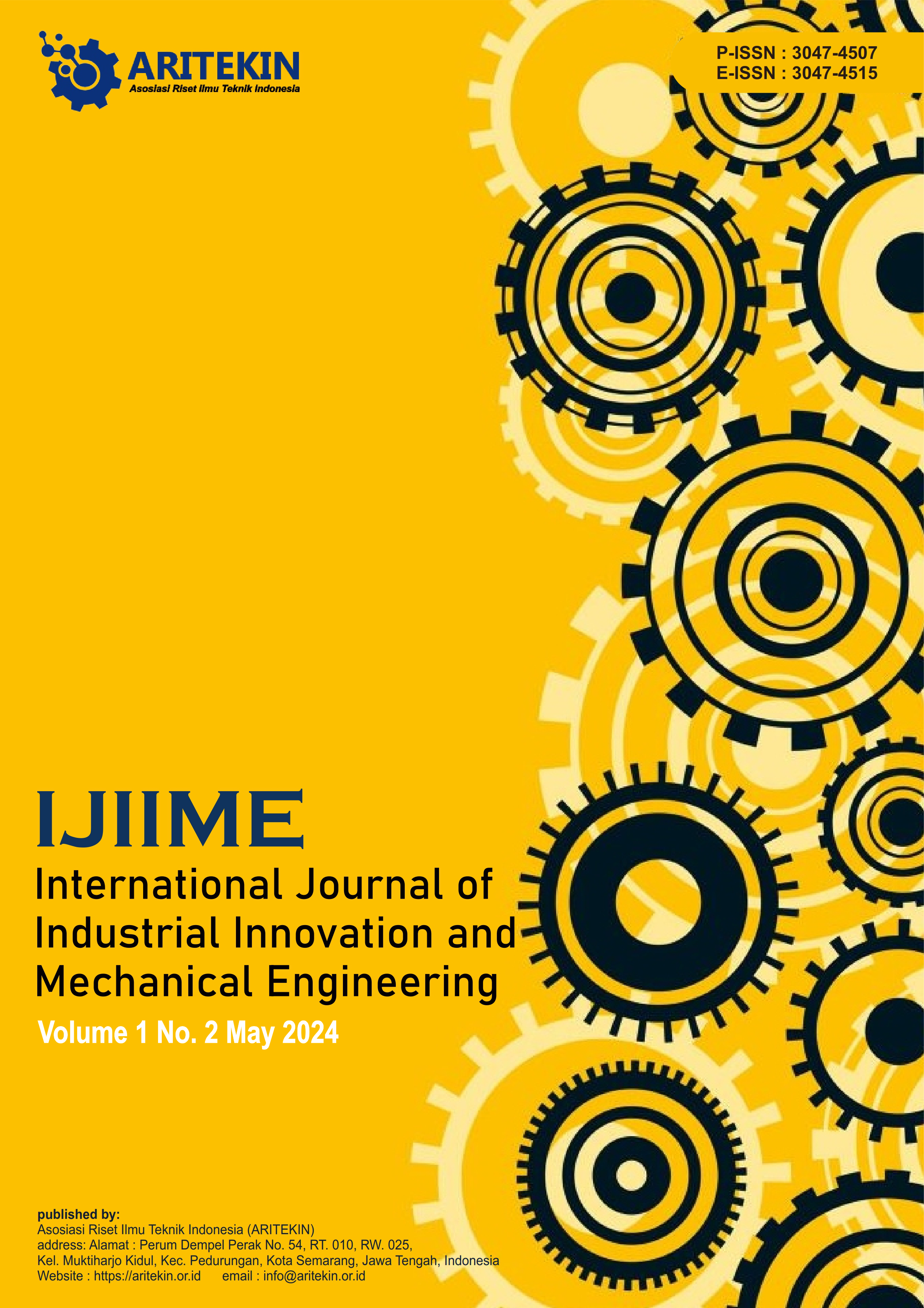Comparison Of The S Curve With The CPM Method In Analyzing Project Scheduling
DOI:
https://doi.org/10.61132/ijiime.v1i2.18Keywords:
Critical Path Method, S curve method, Critical path, Duration, CostAbstract
Project management is managing projects by considering all aspects of construction projects. A project must run according to plan and can be completed on time, so planning is needed before a project runs; scheduling must be considered. Scheduling is an important step in determining the exact duration and sequence for each activity in the project to create a logically structured schedule that can be implemented realistically. Many methods can be applied in project scheduling, such as S Curve and CPM (Critical Path Method). The use of different scheduling methods is considered to affect the final result of scheduling. Therefore, it is necessary to analyze the two methods. The analysis was carried out by comparing the critical trajectory, duration, and cost of structural work on the Kediri Regency Stadium Design and Build Project produced by the two methods so that it can be concluded which method is more efficient. The results showed differences in critical trajectories in the S curve and the CPM methods. In addition, the difference in duration is obtained; the S curve method requires a work duration of 140 days with a cost of Rp 48,041,965,577.96. Meanwhile, the CPM method requires a work duration of 131 days at a cost of Rp 47,535,997,308.05. Based on the results, the CPM method is superior in terms of time and cost.
References
Abadiyah, S., Mu’min, M. A., & Rinaldi, T. I. (2022). Evaluasi penjadwalan waktu dan biaya proyek jalan tol Kunciran-Serpong PT. Waskita Karya (Persero) Tbk. dengan metode PERT dan CPM. Structure (Jurnal Sipil), 1(2), 39. https://doi.org/10.31000/civil.v1i2.6934
Aggraini, N., & Kartini, I. A. N. (2021). Penerapan waktu penyelesaian proyek dengan metode CPM (Critical Path Method): Studi kasus pembuatan jembatan timbang di gudang PPGK milik PT Garam (Persero). JEM17: Jurnal Ekonomi Manajemen, 6(1), 13–26. https://doi.org/10.30996/jem17.v6i1.5273
Alami, N., Aziz, U. A., & Margiarti, D. (2021). Studi komparasi perbandingan rencana anggaran biaya antara metode analisa harga satuan pekerjaan (AHSP) dan Standar Nasional Indonesia (SNI). Suryabeton, 5, 10. https://jurnal.umpwr.ac.id/index.php/suryabeton/article/view/1104
Arianie, G. P., & Puspitasari, N. B. (2017). Perencanaan manajemen proyek dalam meningkatkan efisiensi dan efektivitas sumber daya perusahaan: Studi kasus Qiscus Pte Ltd. J@ti Undip: Jurnal Teknik Industri, 12(3), 189. https://doi.org/10.14710/jati.12.3.189-196
Asnuddin, S., Tjakra, J., & Sibi, M. (2018). Penerapan manajemen konstruksi pada tahap controlling proyek: Studi kasus bangunan laboratorium Fakultas Teknik Universitas Sam Ratulangi Manado. Jurnal Sosial Politik, 7(2), 161–175. https://ejournal.unsrat.ac.id/v2/index.php/jss/article/view/20724
Astari, N. M., Subagyo, A. M., & Kusnadi. (2022). Perencanaan manajemen proyek dengan metode CPM (Critical Path Method) dan PERT (Program Evaluation and Review Technique). Konstruksia, 13(1), 164. https://doi.org/10.24853/jk.13.1.164-180
Aulia, S., & Cipta, H. (2023). Network planning analysis using CPM and PERT methods on optimization of time and cost. Sinkron, 8(1), 171–177. https://doi.org/10.33395/sinkron.v8i1.11961
Bangun, V. H. (2016). Analisa perbandingan waktu penjadwalan proyek dengan metode CPM (Critical Path Method) dan PERT (Project Evaluation and Review Technique). UNUGHA Repository. https://repository.unugha.ac.id/498/
Barwa, T. M. (2017). CPM and PERT comparison analysis in project planning. International Journal of Advanced Engineering and Management Research, 2(4), 1204–1210. https://www.ijaemr.com/uploads/pdf/archivepdf/2020/ijaemr_01_160.pdf
Cristóbal, J. R. S. (2017). The S-Curve envelope as a tool for monitoring and control of projects. Procedia Computer Science, 121, 756–761. https://doi.org/10.1016/j.procs.2017.11.097
Hayun, A. (2005). Perencanaan dan pengendalian proyek dengan metode PERT-CPM: Studi kasus fly over Ahmad Yani-Karawang. The Winners, 6(2), 155. https://doi.org/10.21512/tw.v6i2.605
Hermanto, Mustafa, K., & Banjarnahor. (2019). Analisa jaringan kerja dengan metode CPM pada proyek pembangunan gedung Balai Diklat BPK RI Perwakilan Provinsi Sumatera Utara di Medan. Jurnal Ilmu Manajemen dan Ekonomi, 2(November 2018), 51–56. https://www.ojs.uma.ac.id/index.php/jime/article/view/2437
Ilwaru, V. Y. I., Rahakbauw, D. L., & Tetimelay, J. (2018). Penjadwalan waktu proyek pembangunan rumah dengan menggunakan CPM (Critical Path Method). Barekeng: Jurnal Ilmu Matematika dan Terapan, 12(2), 061–068. https://doi.org/10.30598/vol12iss2pp061-068ar617
Lilyana. (2020). Analisis network planning dengan Critical Path Method (CPM) dalam rangka efisiensi waktu dan biaya proyek pembangunan rumah minimalis: Studi kasus Property Group Medan. Jurnal Sistem Komputer dan Informatika, 2(1), 80–89. https://doi.org/10.30865/json.v2i1.2459
Maddeppungeng, A., & Suryani, I. (2015). Analisis pengendalian penjadwalan pembangunan gedung administrasi Universitas Pendidikan Indonesia (UPI) kampus Serang menggunakan metode Work Breakdown Structure (WBS) dan Kurva-S. Fondasi: Jurnal Teknik Sipil, 4(1). https://doi.org/10.36055/jft.v4i1.1230
Nilawati, N. K. U., & Dharsika, I. G. E. (2020). Penerapan manajemen proyek pada tahap pengendalian waktu pelaksanaan proyek soft landscaping Jumeirah Resort Pecatu Graha Bali. Jurnal Ilmiah Vastuwidya, 3(1), 01–05. https://doi.org/10.47532/jiv.v3i1.94
Rachman, D. N., & Iswendra. (2019). Analisis penerapan manajemen waktu pada rencana proyek pembangunan gedung Cobalt dan Linac RSMH Palembang dengan menggunakan metode CPM. Jurnal Teknik Sipil, 8(2), 81–91. https://doi.org/10.36546/tekniksipil.v8i2.24
Siswanto, A., & Baihaqi, I. (2017). Identifikasi kebutuhan sistem monitoring dan pengendalian multi-proyek konstruksi dengan metode House of Quality. Accounting and Management Journal, 1(2), 115–132. https://journal2.unusa.ac.id/index.php/AMJ/article/download/79/59/112
Sutomo, Y., Anwar, S., & Firmanto, A. (2016). Analisis manajemen proyek pembangunan kantor PT. Prima Multi Usaha Indonesia. Jurnal Konstruksi, UNSWAGATI CIREBON, 5(4), 435–445. https://jurnal.ugj.ac.id/index.php/Konstruksi/article/view/3825
Sutopo, G. I., & Hendarti, L. (2022). Analisis Kurva-S untuk monitoring pelaksanaan proyek: Studi kasus proyek rumah tinggal di Jalan Cocak II Nomor 3, Surakarta. Jurnal Scer, 32–48. https://ejurnal.unsa.ac.id/index.php/scer/article/view/11
Wibowo, P., & Rozy, N. (2020). Analisis manajemen konstruksi pembangunan gedung rawat inap kelas III RSUD Waled Kabupaten Cirebon. CIREBON Jurnal Konstruksi, 9(2), 125–138. http://jurnal.ugj.ac.id/index.php/Konstruksi/article/view/3773
Wiratmani, E., & Prawitasari, G. (2015). Penerapan metode jalur kritis dalam penyusunan jadwal pelaksanaan proyek pembangunan fasilitas rumah karyawan. Faktor Exacta, 6(3), 210–217. https://journal.lppmunindra.ac.id/index.php/Faktor_Exacta/article/viewFile/233/219
Downloads
Published
How to Cite
Issue
Section
License
Copyright (c) 2024 International Journal of Industrial Innovation and Mechanical Engineering

This work is licensed under a Creative Commons Attribution-ShareAlike 4.0 International License.





